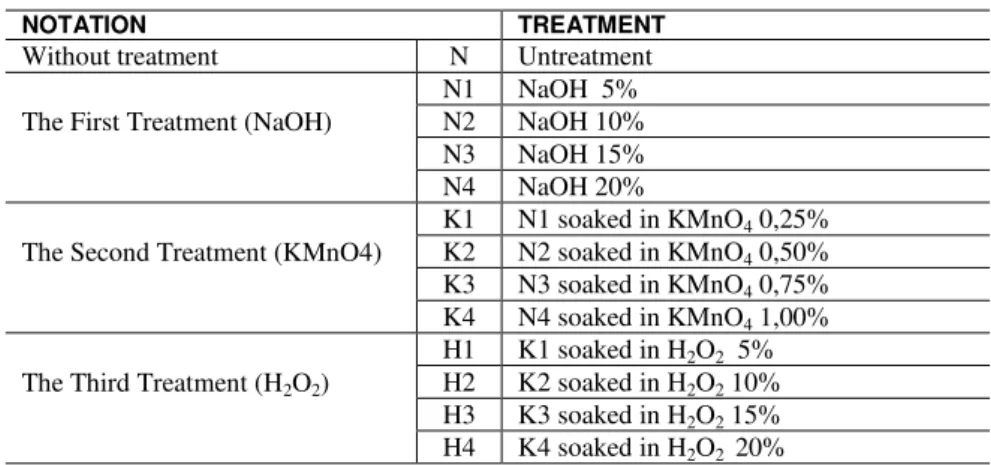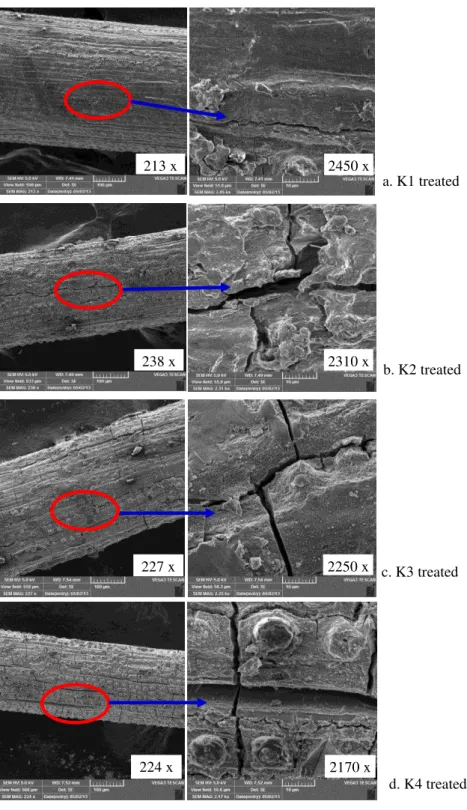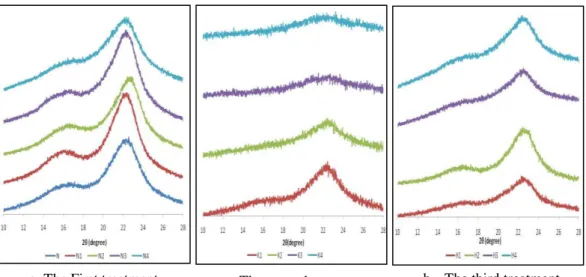Corresponding Author: Muhammad Arsyad
10.1590/S1517-707620150001.0017
Received on: 29/08/2014 Accepted on: 11/12/2014
The morphology of coconut fiber surface
under chemical treatment
Muhammad Arsyad1, I Nyoman Gede Wardana2, Pratikto2, Yudy Surya Irawan2
1
Department of Mechanical Engineering, State Polytechnic of Ujung Pandang e-mail: muhammadarsyadhabe@yahoo.co.id
2
Department of Mechanical Engineering, Brawijaya University, Malang, Indonesia e-mail: wardana@ub.ac.id; pratiktoprawoto@yahoo.com; yudysir@ub.ac.id
ABSTRACT
The objective of this study was to determine the effect of chemical treatment on the coconut fiber surface morphology. This study is divided into three stages, preparation of materials, treatment and testing of coconut fiber. The first treatment is coconut fiber soaked in a solution of NaOH for 3 hours with concentration, respectively 5%, 10%, 15%, and 20%. The second treatment is coconut fiber soaked in KMnO4 solution with a concentration of 0.25%, 0.5%, 0.75%, and 1% for 3 hours. The third treatment is coconut fiber is soaked in H2O2 solution with a concentration of 5%, 10%, 15%, and 20% for 3 hours. At each treatment the fiber is dried in an oven at a temperature of 90oC for 5 hours. Coconut fibers that had been the first, second, and third treated, sorted out for chemical composition, single fiber tensile and SEM testing. Tensile strength of single coconut fiber was tested following ASTM 3379-02 by using a tensile testing LR10K Plus 10 kN Universal Materials Testing Machine. The fiber surface morphology was examined using electron microscopy Vega3 Tescan Scanning Electron Microscope (SEM) at 5kV voltage, and X-ray diffraction, 30 kV, 15 mA, at scan speed 2.000 deg./min . The result shows that the highest tensile strength of the fiber obtained in the first treatment namely N4. In general the mechanical strength of the fiber decrease slightly however, the fiber surface morphology becomes rough. NaOH treatments cause crystallization on the surface of the fiber. Crystallinity index was decreased with increasing concentration of NaOH. The second treatment caused the trench grooves on the surface of the fiber that can improve bonding between fiber and matrix.
Keywords: coconut fiber, treatment, chemical, morphology, crystallization
1.INTRODUCTION
The main content of coconut fiber is cellulose, hemi-cellulose, and lignin. The lignin content in coconut fi-bers is very high [1,2,3]. Cellulose and hemi-cellulose is a polysaccharide compound while lignin is a mac-romolecules polyphenolic compound [2]. The strength or ductility of composite can be obtained by taking into account the bond between the fiber surface with a matrix, the way to construct the fiber, and reinforcer component should have a higher elastic modulus than the matrix. The properties of the composite is strongly determined by compatibility between natural fibers with a matrix [4].
Natural fibers have a hydrophilic nature [5]. In addition, the surface of natural fibers also has dirt and other substances that may affect the bonding strength of the fibers with the matrix. Therefore, various studies have been done to improve the surface of natural fibers in order to have a good bonding strength between natural fibers with the matrix. Coconut fiber is very good to be used as a filler in the composite because it has several advantages such as: strong, lightweight, heat resistant, salt water resistant, cheap, and easily obtained [6,7].
170 fatigue life for a large stress composite reinforced with coconut fiber treated with sodium hydroxide [13].
In general, treated natural fibers used as a composite reinforce treatment give tensile strength and modulus of elasticity greater than the untreated natural fiber composites. Therefore, modification of the fiber surface treatment is considered to increase the strength of natural fiber Composite [13, 14]. Surface treatment using stearic acid and potassium permanganate other than NaOH provide a better performance than the un-treated fibers [14]. Hydrogen peroxide (H2O2) was also used in coconut fiber treatment [9, 15]. In addition to chemical treatment, coconut fiber is treated by washing and boiling to remove dirt on the surface of the fiber so as to produce a cavity [2, 16].
Structural characteristics and chemical composition made tensile strength and modulus of elasticity of coconut fiber relatively low compared to other natural fibers. However, coconut fiber has special advantages such as large strain, low density, and weather resistant so that it is good for functional material [17].
Generally in previous studies, fiber was treated only in one step [8, 9, 10, 16] or two steps [18]. However, in this study chemical treatment for coconut fiber was done in three steps, namely first step was NaOH treatment, the second step was KMnO4 treatment and the third step was H2O2 treatment, with varying concentrations. Moreover, after each step of treatmen, the fiber was immediately dried in an oven without washed with distilled water [13]. The objective of this research is to study the effect of chemical treatment on coconut fiber surface morphology.
2. MATERIALS AND METHODS
Coconut fiber in this experiment was obtained by separating the fiber from coconut husk and corks. Chemical solution for fiber surface treatment was prepared by dissolving sodium hydroxide (NaOH) in distilled water with the composition of 5%, 10%, 15%, and 20%; hydrogen peroxide (H2O2) with the same composition, and the potassium permanganate (KMnO4) with 0.25%, 0.5%, 0.75%, and 1% as tabulated in Table 1.
Table 1:Notation of coconut fiber surface treatment
NOTATION TREATMENT
Without treatment N Untreatment
The First Treatment (NaOH)
N1 NaOH 5%
N2 NaOH 10%
N3 NaOH 15%
N4 NaOH 20%
The Second Treatment (KMnO4)
K1 N1 soaked in KMnO4 0,25% K2 N2 soaked in KMnO4 0,50% K3 N3 soaked in KMnO4 0,75% K4 N4 soaked in KMnO4 1,00% The Third Treatment (H2O2)
H1 K1 soaked in H2O2 5% H2 K2 soaked in H2O2 10% H3 K3 soaked in H2O2 15% H4 K4 soaked in H2O2 20%
The three types of treatment are listed in Table 1. Untreated coconut fiber was given notation N. In the first treatment noted as N1, N2, N3, and N4, the fiber was soaked into NaOH solution with concentration as in table 1 each for 3 hours. After that the fiber was dried in an oven at a temperature of 90oC for 5 hours and then it was cooled to room temperature. In the second treatment noted as K1, K2, K3, and K4, the fiber that had been treated with N1, N2, N3, or N4 was soaked into KMnO4 solution with concentration as in table 1 each for 3 hours. After that the fiber was dried in an oven at a temperature of 90oC for 5 hours and then, it was cooled to room temperature. In the third treatment noted as H1, H2, H3, and H4, the fiber that had been trated with K1, K2, K3, or K4 was soaked into H2O2 solution with concentration as in table 1 each for 3 hours and then the fiber was dried in an oven at a temperature of 90oC for 5 hours. After that it was cooled to room temperature.
171
%
100
002 101
002
x
I
I
I
I
C
where I002 is the maximum intensity of the 002 lattice reflection and I101 the intensity of diffraction. The crystallinyti index of coconut fiber of the first treatment is shown in Tabel 2.
3. RESULTS
Figure 1: Surface morphology of fiber without and with the first treatment
e. N4 d. N3 c. N2 b. N1 trea-a. N untreated
2060 214 x
2240 234 x
289 x 4560
229 x 2330
172 Figure 1 shows SEM images of coconut fiber surface morphology. Figure 1a shows the surface morphology of the untreated fiber, Figure 1b-e shows that of coconut fiber that had been treated with NaOH (first treatment), Figure 2a-d shows the surface morphology of coconut fiber that has been given a second treatment (NaOH then KMnO4), and Figure 3a-d shows that of coconut fiber that has been given a third treatment (NaOH then KMnO4 then H2O2).
Figure 2: Surface morphology of coconut fiber with the second treatment
Figure 2a-d shows that the fibers treated with NaOH then KMnO4 causes grooves like trenches and an in-crease in roughness of the fiber surface.
d. K4 treated c. K3 treated
b. K2 treated a. K1 treated
213 x 2450 x
238 x 2310 x
227 x 2250 x
173
Figure 3: Surface morphology of coconut fiber with the third treatment
226 x 2140 x
2310 x 243 x
2320 x 238 x
2360 x 226 x
174
Figure 4: X-Ray Diffraction diagrams
Table 2:Criystallinity index for the first treatment
TREATMENT I(101) I(002) IC (%)
N 2.116,11 5.309,07 60,14
N1 2.540,86 6.745,58 62,33
N2 2.101,42 5.508,30 61,85
N3 2.713,79 7.019,27 61,34
N4 3.179,72 5.791,28 45,09
Figure 5: Tensile strength of coconut fiber at several treatments
Figure 4 shows the X-Ray Diffraction at three treatments. The figure shows that the X-Ray Diffraction is different at each treatment and Figure 5 shows the tensile strength of coconut fiber for all treatment.
175
4. DISCUSSION
Figure 1a shows the untreated coconut fiber. The coconut fiber surface is rather smooth [10, 13]. This indi-cates that the fiber surface is still filled with impurities or other elements. Figure 1b-e shows the rough sur-face of the fiber due to the crystallization of NaOH solution for drying at a temperature of 90oC for 5 hours. Figure 1b-d shows large grain crystallizations whereas in Figure 1e shows small grains merge with each other so it looks sturdy. Alkali treatment makes the roughness of fiber surface very different from the untreated fiber surface [8, 10, 13]. Increased surface roughness of coconut fiber as the effect of increasing the amount of cellulose exposed [8]. Nevertheless, the roughness is not permanent because crystallization of NaOH can be released easily when the fiber is soaked in other solution. This occurred after the fiber was soaked in a solution of KMnO4 as shown in Figure 2a-d. Fiber surface morphology showed that the crystallization NaOH disappears. Crystallization which is reduced or lost is also visible in Figure 4b, the XRD test results show an almost straight line except in the treatment of K1. Besides that, Figure 4 shows the diagrams of XRD for untreated and treated coconut fiber. Figure 4a shows that the N4 line width peak of diffraction are the great-est. This means that the N4 treatment causes small crystallization with, crystallinity index of 45,09 % as show Tabel 2. It is clear that the decrease of the crystallinity on N4 treatment involving depolymerization, and it is evidence of the decrease of intensity [19].
Table 2 shows that the first treatment with NaOH decreases crystallinity index with increasing NaOH concentration. It is also reflected in the SEM results, decreasing of crystal size with increasing of NaOH concentrations. These results were also seen in the XRD profile in Figure 4a with the lower intensity peak, means that the smaller the crystals size [9]. Overall, if compare with fiber untreated, crystallinity index was increase after alkali treatment [20]. In the second treatment with KMnO4 solution change of the fiber surface morphology seen in the SEM results (Figure 2). These results is appropriate with the XRD results in Figure 4b which shows a different of diffraction pattern with tendency of peak is lower for the second treatment. This indicates a loss of crystallinity due to the second treatment. In the third treatment with H2O2 solution, crystallization phenomenon was seen again with the appearance of the diffraction peaks as shows Figure 4c. However, based on morphological images obtained from SEM, there are differences of crystallized form that occurs between the first and third treatment. Crystallized form could be different between treatments due to the different chemical reactions that occur on the surface of the fiber. The phenomenon of crystallization in the third treatment may be caused by the reaction between cellulose with hydrogen [20].
The crystallization wrap up coconut fiber so that it becomes stronger. As a result, the tensile strength of the coconut fiber becomes larger than the other treated of fibers. The roughness looks tougher than that in Figure 1b-e. Grooves size is proportional to the concentration of KMnO4. Grooves are expected to facilitate the matrix to fill the grooves so that it can improve the bonding strength between the fiber and the matrix. Figure 3a-d shows that in the third treatment the grooves on the surface of the coconut fiber are covered by H2O2 solution in the form of patches. Although the fiber grooves covered by patches the tensile strength of the fiber tends to fall with increasing concentrations of hydrogen peroxide, as shown in Figure 5. This is due to the fact that the patches are not able to properly fill the grooves and does not become a single unit as seen clearly in Figure 3a-d. This results in the maximum strengths as shown in Figure 5, which is 345.78 MPa. This indicates that the coconut fiber soaked in 20 % NaOH solution have a significant effect on the surface of the coconut fiber. The maximum tensile strength increase of approximately 85.6% of the untreated fibers which is 186.33 MPa [10]. This occurs because the fibers are covered by crystallized NaOH as shown in Figure 1e.
5. CONCLUSIONS
Three steps of chemical treatment have been applied on the coconut fiber. It can be concluded that:
1. Chemical treatment can change the surface morphology of coconut fiber to become rougher though its mechanical strength decreases slightly.
2. The first treatment leads to crystallization on the surface of the fiber, while the second treatment creates trench groove on the surface of coconut fiber.
3. Crystallization index is inversely proportional to the concentration of alkali solution.
6. ACKNOWLEDGMENTS
176 the head of State Polytechnic of Ujung Pandang, Makassar Academy of Industrial Engineering, State Univer-sity of Makassar and the facilities that have been used.
7. BIBLIOGRAPHY
[1] WAIFIELATE, A.A., ABIOLA, B.O., Mechanical property evaluation of coconut fibre, Master’s Degree
Thesis, Department of Mechanical Engineering Blekinge Institute of Technology, Sweden, 2008.
[2] MUENSRI, P., KUNANOPPARAT, T., SIRIWATTANAYOTIN, S., at al. “Effect of lignin removal on the properties of coconut coir fiber/wheat gluten composite”, Composites, v. 42, pp. 173-179, 2011.
[3] KHALIL, A.H.P.S., ALWANI, M.S., OMAR, A.K.M., et al., “Chemical composition, anatomy, lignin distribution, and cell wall structure of malaysian plant waste fibers”, Bioresources, v. 1, n. 2, 220-232, 2006. [4] ROZMAN, H.D., TAN, K.W., KUMAR, R.N., at al., “The effect of lignin as a compatibilizer on the physical properties of coconut fiber-polypropylene composites”, European Polymer Journal., v. 36, pp. 1483-1494, 2000.
[5] DIXIT, S., VERMA, P., “The effect of surface modification on the water absorption behavior of coir fibers”, Advances in Applied Science Research, v. 3, n. 3, pp. 1463-1465, 2000.
[6] SEN, T., REDDY, H.N.J., “Application of sisal, bamboo, coir and jute natural composites in structural upgradation”, International Journal of Innofation, Management and Technology, v. 2, n. 3, 186-191, June. June, 2011.
[7] ROSA, M.F., CHIOU, B., MEDEIROS, E.S., et al., “Effect of fiber treatment on tensile and thermal properties of starch/ethylene vinyl alcohol copolymers/coir biocomposites”, Bioresource Technology, v. 100, pp. 5196-5202, 2009.
[8] AHAD, N.A., PARIMIN, N., MAHMED, N., et al. “Effect of chimical treatment on the surface of natu-ral fiber”, Journal of Nuclear and Related Technologies, v. 6, n. 1, pp. 155-158, 2009.
[9] CARVALHO, K.C.C., MULINARI, D.R., VOORWALD, H.J.C., et al., “Chemical modification effect on the mechanical properties of hips/coconut fiber composites”, Bioresources, v. 5, n. 2, pp. 1143-1155, 2010. [10] KARTHIKEYAN, A., BALAMURUGAN K., “Effect of alkali treatment and fiber length on impact behavior of coir fiber reinforced epoxy composites”, Journal of Scientific & Industrial Research, v. 71, pp. 627-631, September, 2012.
[11] KARTHIKEYAN, A., BALAMURUGAN, K., KALPANA, A., et al., “The new approach to improve the impact property fiber reinforced epoxy composites using sodium laulryl sulfate treatment”, Journal of Scientific & Industrial Research, v. 72, pp. 132-136, February, 2013.
[12] AZMI, M.A., YUSOFF, M.F.C., ABDULLAH, Z.A., et al., “Rigid polyurethane foam reinforced coco-nut fiber propoerties”, International Journal of Integrated Engineering, v. 4, n. 1, pp. 11-15, 2012. [13] MULINARI, D.R., BAPTISTA, C.A.R.P., SOUZA, J.V.C., et al., “Mechanical properties of coconut fibers reinforced polyester composites”, Procedia Engineering, v. 10, pp. 2074-2079, 2011.
[14] LAI, C.Y., SAPUAN, S.M., AHMAD, M., et al. “Mechanical and electrical properties of coconut coir fiber-reinforced polypropylene composites”, Polymer-Plastics Technology and Engineering, v. 44, pp. 619-632, 2005.
[15] HUSSAIN, S.A., PANDURANGADU, V., PALANIKUAMR, K., et al., “Mechanical properties of green coconut fiber reinforced HDPE polymer composite”, International Journal of Engineering Science and Technology, v. 3, n. 11, pp. 7942-7952, November, 2011.
[16] FERRAZ, J.M., MENEZZI, C.H.S.D., Teixeira, D.E., et al., “Effect of treatment of coir fiber and ce-ment/fiber ratio on properties of cement-bonded composites”, Bioresources, v. 6, n. 3, pp.3481-3492, 2011. [17] YAO, J., HU, Y., LU W., et al., “A wood replacement material of sandwich structure using coir fiber mat and fiberglass fabrics as core layer”, Bioresources, v. 7, n. 1, pp. 663-674, 2012.
[18] ABDULLAH, NURUL MUNIRAH., and AHMAD, ISHAK., “Effect of chemical treatment on me-chanical and water-sorption properties coconut fiber-unsaturated polyester from recycled PET”, International Scholarly Research Network (ISRN) Materials Scince, 2012.
177 [20] SINHA, E., ROUT, S, K. “Influence of fibre surface treatment on structural, thermal and mechanical



